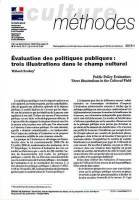The evaluation of public policies enables an assessment to be made of how efficiently a measure has been implemented and how effective it is in itself, evaluated in accordance with defined criteria and justifying public intervention. There is a range of different public policy evaluation methodologies, with economics providing various tools for econometric evaluation.
A direct comparison of the beneficiaries and non-beneficiaries of a given measure will give a biased evaluation, as, generally speaking, both groups will have quite different characteristics. Econometric methods all avoid this problem by taking an "all other things being equal" approach, i.e. by isolating the effect of a given measure in order to assess its own specific impact. In accordance with RUBIN’s causal model, an evaluation compares an observed situation with that which one might observe in the absence of any public intervention. The latter is referred to as the counterfactual situation; it is fundamentally unobservable, so econometric methods aim to supply as precise an assessment as possible. The three most standard methods are outlined here and are illustrated using three public intervention initiatives from the cultural sphere: the LiR label initative, the Schools & Cinema initiative and the audiovisual tax credit scheme.
In the case of the LiR label, it aims to determine whether this labelling scheme has enabled certain bookshops to improve their profitability. The LiR label enables a theoretical exposition of the difference in differences or double differences method, which compares labelled and non-labelled bookshops both before and after creation of the label in order to evaluate its efficacy.
For the Schools and Cinema initiative, the assessment looked at whether this scheme had helped develop young people's taste for the cinema by analysing young people's annual cinema attendance rates. School and Cinema provides an illustration of the instrumental variables method which involves taking an exogenous variable which has no direct effect on cinema attendance levels in young adults but which explains the participation of these young people in the programme at primary school level.
Finally, regression discontinuity design is used to assess the audiovisual tax credit scheme, analysing the aim of attracting production expenditure to France by measuring the number of days spent filming on French soil by production companies. This method involves using an existing selection rating for scheme participants, restricting the evaluation to those nearest the threshold for tax credit qualification in order to imitate a random selection of the individuals in the programme.
Rather than an evaluation of the schemes shown here for illustrative purposes, this publication aims to outline those tools which are still under-used in the evaluation of cultural policy.
Partager la page

